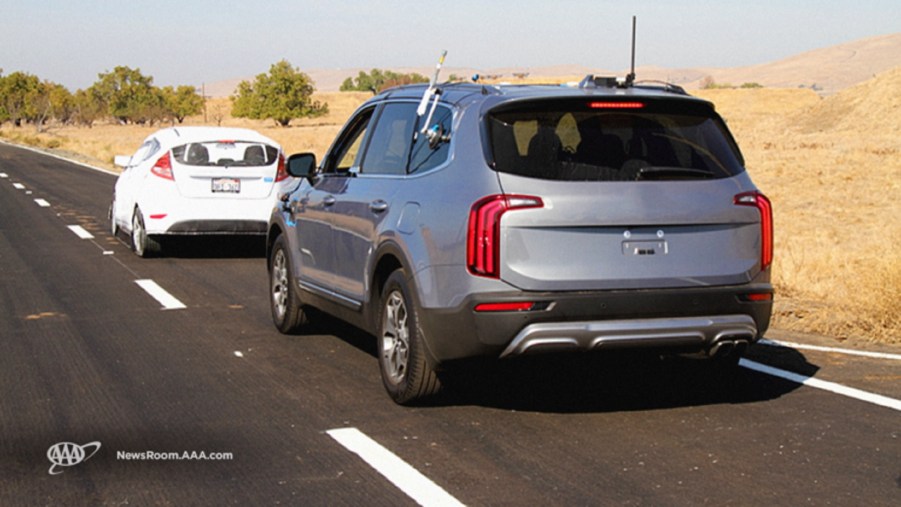
Today’s ADAS Features Aren’t Advanced Enough
Advanced driver-assistance systems have rapidly become a critical part of automotive safety. ADAS features like lane-keeping assist, adaptive cruise control, and automatic emergency braking are now standard in many vehicles. However, not everyone understands their limitations. This is especially worrying in the face of a new study which shows they’re not as foolproof as many believe.
AAA’s ADAS study
AAA ran the study, which looked at 5 ADAS-equipped vehicles from the 2019 and 2020 model years. Specifically, a 2019 BMW X7, a 2019 Cadillac CT6, a 2019 Ford Edge, a 2020 Kia Telluride, and a 2020 Subaru Outback.

Each manufacturer calls its ADAS features suite something different, Car and Driver reports. For example, the CT6 comes with GM’s ‘Super Cruise’; Ford has ‘Ford Co-Pilot360’; and Kia has ‘Highway Driving Assist.’ Also, not every feature comes standard with the suite. For example, although every BMW X7 has lane-departure warning and automatic emergency braking, adaptive cruise control is optional, Car and Driver reports.

AAA’s study, which took place on closed courses and several California highways, focused on several different metrics, Motor1 reports. Evaluators tested the lane-keeping assist’s accuracy and efficacy, as well as the performance and detection limits of the automatic emergency braking, collision warning, and traffic alert. And the adaptive cruise control’s distance-maintaining capabilities were tested in simulated and real-world traffic, complete with fluctuating speeds.
The results weren’t necessarily reassuring, Reuters reports. The ADAS study covered over 4000 real-world miles split equally between the 5 vehicles. And during that time, the drivers encountered a fault roughly every 8 miles, often with little warning. On public roads, 73% of those faults were due to improper lane positioning, or straight-up lane departure. And when the cars encountered a simulated disabled vehicle, 66% of the time they drove into it at an average speed of 25 mph.

Of the ADAS suites tested, Cadillac’s Super Cruise encountered the fewest issues, while the Ford Edge saw the most. The X7 came in at #2, and the Subaru Outback at #3.
ADAS-equipped cars aren’t self-driving, even if people think they are
Each of the 5 cars’ ADAS suites is considered Level 2 on SAE’s autonomy scale, Roadshow reports. Tesla’s AutoPilot is also a Level 2, or ‘partially-autonomous’ system. This means the vehicle can at times control its own speed, braking, and steering, but an alert human being has to be standing by at all times to intervene. This emphatically does not make them self-driving.
However, that’s not always apparent to these vehicles’ owners. In a study published in September 2018, AAA reported that roughly 25% of drivers were okay with doing other tasks while driving as long as their cars had forward-collision or lane-departure warning systems. Not automatic braking, mind you, but just warning systems, which are not the same thing. And yet, almost 40% of surveyed drivers thought they were, Forbes reports.
The problem is that no ADAS feature is a replacement for proper care and driving techniques. For example, look at backup cameras. They’re not technically part of ADAS, but they have decreased deaths and injuries due to reversing collisions. But they also made drivers pay less attention to the sides of their vehicles. As a result, while deaths dropped by 31%, CBS News, and the Washington Post report, injuries only decreased 8%.
What’s the solution?

These systems are improving bit by bit as the technology does. Some new lidar sensors are smaller than a deck of cards and cost less than a Nintendo Switch Lite. With more sensors comes better resolution, improving the car’s capability of sensing and reacting to environmental changes. But that also might mean even higher repair costs if a collision occurs.
However, the best way to address these issues is to focus on the responsible party: the driver. First, it’s important to know your vehicle’s ADAS limitations. That includes knowing what speeds it can handle, how long its sensors reach, and so on. And secondly, if you use these features, always pay attention and be prepared to take the wheel. ADAS does not drive your car for you, and it can’t always see every pedestrian or cyclist. You are still in charge of the vehicle—you’re just getting a bit of extra help.
Follow more updates from MotorBiscuit on our Facebook page.


